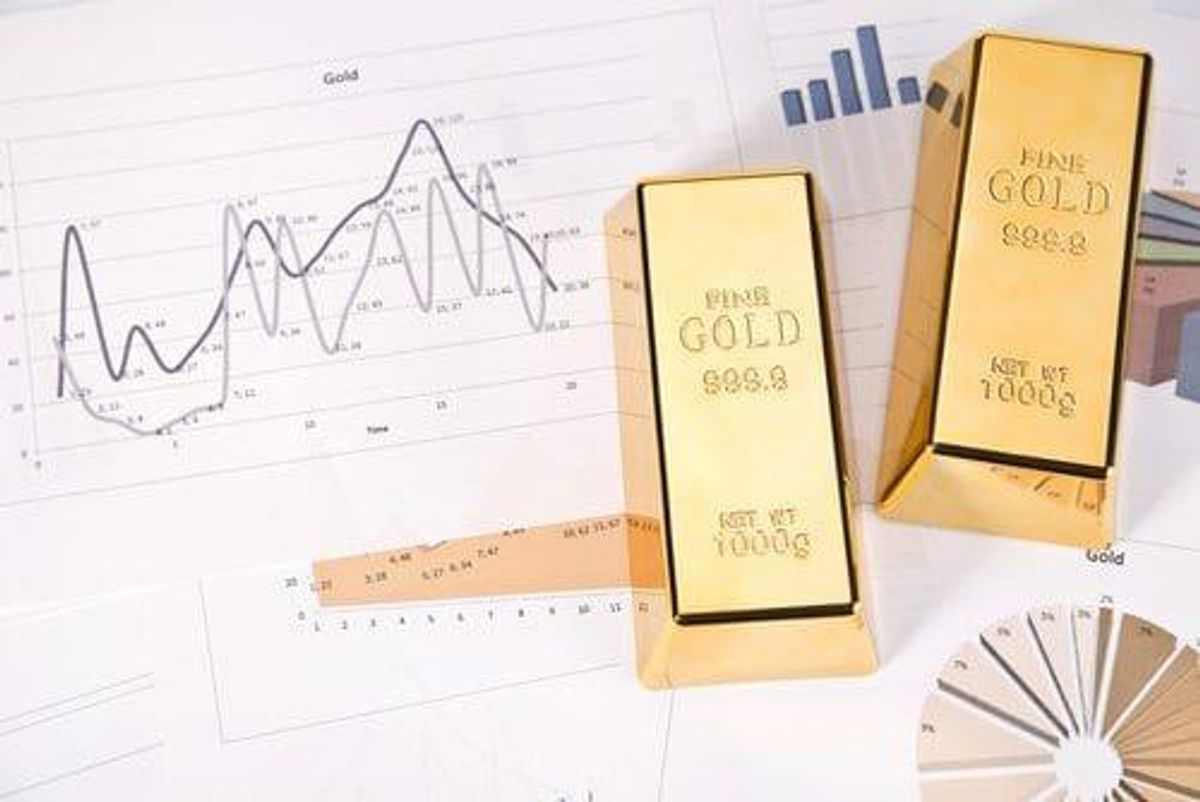
Interested in gold stocks? Find out why investors should consider buying stocks and what makes a good gold stock.
As the price of gold continues to climb, with stocks moving in tandem, many investors have begun to wonder if now is the perfect time to introduce gold stocks to their portfolio.
While there are many different ways to invest in the precious metal, there are certain upsides that only gold stock investing can provide.
Before exploring various stocks that you may want to include in your portfolio this year, it is important to understand whether gold stocks are right for you. Below is a break down of what gold stocks are, a comparison of investing in gold stocks versus physical gold and factors that affect the value of a gold stock.
What is a gold stock?
Like all publicly listed stocks, gold companies issue shares that are available for investors to trade. When you purchase shares of a gold stock, you are essentially purchasing a stake in the company, making financial returns or losses from its profits.
There are two main types of stocks from which an investor can purchase shares. The first is when market participants purchase through a major mining company. The other way of trading on the stock market is by investing in a gold mining stock through a junior miner. It is worth noting that, while both avenues have their pros and cons, if you invest in a junior gold stock, it can be inherently risky. Since these companies often fail due to the risks associated with exploration and development, you stand a greater chance of also taking on a loss when you buy gold this way.
Finally, market participants can also obtain gold shares through investing in gold streaming and royalty companies, such as Wheaton Precious Metals (TSX:WPM,NYSE:WPM).
Although no gold stock investing is 100 percent foolproof, backing a successful mining company in the precious metals space can alleviate some of the stress of a down stock market when you keep in mind that if a company’s share price goes down, it becomes more affordable to purchase and investors can more than likely anticipate that it will rise again and turn a profit.
Gold stocks vs physical gold
In order to understand the difference between investing in physical gold versus investing in a gold stock, let’s break down what physical gold is and how it is traded.
Physical gold
Purchasing physical gold bullion via gold bars, gold bullion coins and jewelry is the most direct way to buy the yellow metal.
Physical gold investors are generally looking for items that are 0.999 fine. Several products fit this description, and one of the most preferred is gold bullion coins, such as the South African Krugerrand or the American Gold Eagle.
Another option is gold rounds, which are similar to coins, but are not legal tender. Both gold coins and gold rounds come in various sizes, usually ranging from 1/10 ounce to 1 ounce, though other less common sizes are available.
Investors also access physical gold via gold bars, which, like gold coins, come in a variety of sizes.
Gold buying can be done through government mints, private mints, precious metals dealers and even jewelry stores. Physical gold can either be bought and then sold for immediate compensation or an investor can choose to go the route of gold futures by entering into a futures contract. A futures contract is an agreement to buy or sell gold on a date in the future for a price that is determined when the contract is initiated. In this case, no tangible metal is ever exchanged; therefore, futures contracts are more typically used in paper trading.
As previously mentioned, while investing in physical gold within the mining industry is the most direct way to obtain the yellow metal, it can also be the most expensive avenue, which is why many market participants are turning to gold stocks.
In addition to premiums, there are numerous other cash costs and expenses that investors should be prepared to pay when buying pure gold, including shipping, handling and insurance. There may also be processing fees to owning the yellow metal or small lot fees for small purchases. In some instances, prices may be higher for individuals who choose to pay with a credit card
Due to the fact that gold stocks are not a tangible investment, market participants are owning the metal without having to pay the fees associated with physical assets. Gold stocks are also often times looked at as a more lucrative portfolio add because of their growth potential over purchasing physical gold.
Since 10 ounces of gold today will remain the same 10 ounces of gold in the years that follow, owning physical gold doesn’t produce the same kind of income stream that owning shares does. Due to the fact that gold companies tend to expand over time, investors can benefit from gains in gold production — an added bonus that does not come with holding gold bullion.
Factors that affect the value of a gold stock
While gold stocks are affected by some of the same factors that shape and shift the price of gold, they keep some distance from a direct correlation because it is possible for a gold miner and its stocks to be doing well even in a down market.
Due to this, what affects the value of a gold stock can be broken down into internal and external factors. Internal factors surround the source of the stock — the gold mining company and the production of the yellow metal within the gold space. External factors deal with the state of the economy, the power of the US dollar, interest rate hikes or cuts and possible geopolitical issues, all of which have direct consequences on the price of gold.
Internal factors
The first factor that can shape a gold stock for better or worse is the gold producer that you, as an investor, have purchased the stock from. As previously mentioned, there are two main ways to make gold stocks an asset in your portfolio. The first is through large cap gold companies, which are known for the lower level of risk that comes with investing in them. While some companies have an easier time multiplying share price than others, investors are not likely to experience stock that rises 10 times in value (also known as a 10 bagger).
Despite them not being able to rocket in price, investing in a large cap company also protects market participants from large swings within the market. If there are no bolstered gains, there are no extreme losses either. A large gold producer is generally easy to value as they sell at large-cap valuations.
The second way of gold stock investing is through small cap companies. Investing in junior mining stocks can be tricky, and it is often challenging for investors to find the right winners within the stock market.
If a junior makes a big discovery, very few of them have the mining operations necessary to develop a property; for many, the goal is to hit upon a deposit that’s attractive enough to catch the attention of a major producer that will buy it from them at a profit.
Even though the odds of success are low, many investors are attracted to junior mining stocks. Resource specialist Peter Krauth of Money Morning writes, “All it takes is just one 10 bagger to make up for all the dogs in the pound.”
This is to say that market participants must do their due diligence in the company they purchase stock from, because this will have a direct impact on the value of a gold stock. The Investing News Network (INN) has put together a handy guide of investment tips, which would be beneficial for anyone looking to invest in gold on the stock market.
The second internal factor that sways the value of a gold stock is production of the yellow metal. When investing in gold stocks, it is important to understand that they have a direct relation to gold production. If an investor has purchased a share from a company that is experiencing a high level of production, they can get more for their return based on those production rates.
However, the downside to this relationship can be seen if an investor has purchased shares from a company that is experiencing low levels of production or if extraction of the yellow metal has cost the company a significant amount of money. Production can also be negatively pressured by harsh environmental issues where the mines reside, shutdowns due to care and maintenance and even mine strikes from local workers.
When looking at gold stocks from the lens of how it can be affected by gold production, it appears to be an investment with more risk for more reward.
External factors
Due to the fact that gold stocks will be affected by the price of gold, the variants that move the price of gold also have the potential to send the value of a gold stock either up or down.
With gold recently shooting past the US$1,500 per ounce level for the first time in over six years, external factors are currently affecting the price of gold in a positive way. The first element supporting gold is the fact that the US dollar has lost a lot of the steam that it gained last year and into the beginning of 2019. Since gold has a negative correlation to a thriving greenback, the dollar’s recent decline has been supporting the yellow metal and in turn the value of many gold stocks.
Secondly, a basket of geopolitical issues have sent investors running towards the safe haven nature of gold. Most recently, trade war tensions have ratcheted up since US President Donald Trump announced last week that the country will be adding a 10 percent tariff on another US$300 billion worth of Chinese imports. The new tariffs will come into effect on September 1. Since then, China has stopped new purchases of American agricultural goods and has devalued its currency in an effort to minimize the effects of the tariffs.
Finally, gold and gold stocks are being supported by an interest rate cut, which was implemented by the US Federal Reserve at the end of last month for the first since 2008. While the metal initially retreated following the announcement, it has since steadily increased once the decreased rates were put into place.
While the yellow metal and in turn gold stocks are currently experiencing a bull market and are being positively affected by outside forces, these are the same factors that can also cause gold and gold stocks to dip. When the US dollar is rallying, when gold becomes too expensive to hold and when the Fed decides on an interest rate hike instead of a cut, the markets will generally see a decline in the price of the precious metal, as well as the ways in which it can be invested.
So, what are some of the current best gold stocks to buy? Check out INN’s list of the Best Gold Stocks of 2019 on the TSX to find out.
INNdepth
Want more details? Check out these articles for more INNdepth coverage.
- Gold Stocks and Gold Production: A Beginner’s Guide
- Best Gold Stocks of 2019 on the TSX
- Best Junior Gold Stocks of 2019 on the TSXV
- 4 Gold Stocks to Watch in 2019
Want and overview of investing in gold stocks? Check An Overview of Gold Stocks and Price.
Don’t forget to follow us at @INN_Resource for real-time news updates!
Securities Disclosure: I, Nicole Rashotte, currently hold no direct investment interest in any company mentioned in this article.




